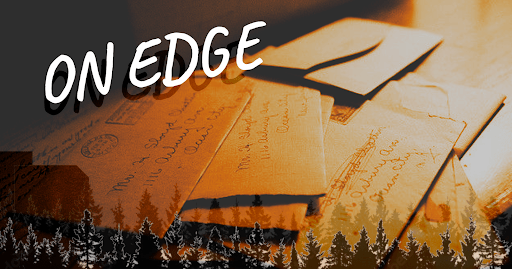Artist’s Statement
Dear player, embark on a journey through the splintered landscape of Rowan’s memories, where the truth awaits assembly. You are the keeper of her secrets, the unraveler of her truths. As you delve into the labyrinth of her mind, remember that memories are fragile, like whispers in the wind. They can be lost, distorted, or hidden. Yet, it is in piecing together these fragmented memories you will uncover the essence of Rowan’s story: a tale of love and betrayal. Tread carefully, for in the world of memories, the truth is a delicate thing.
In On Edge, we aim to craft an immersive narrative experience that balances puzzle-solving with emotional resonance, targeting adults and more mature audiences who are interested in text heavy, narrative driven games. We decided to create a minimal viable product for our project to showcase the narrative in full. We guide players through the present-day narrative, uncovering the backstory of Rowan, a complex and relatable character struggling with memory loss. As players progress, they must reconstruct Rowan’s past, piecing together fragmented memories and reconciling her past and present. Players through clues slowly learn about her husband’s frustration at her infertility and her sister’s built-up resentment towards her for leaving her family behind for a better life in California. Through iterative playtesting, we refined the game’s cohesion, difficulty, and narrative clarity. The addition of interactive elements, such as a functional phone app, enhances the sense of realism. By addressing player feedback and iterating on design, we created an engaging experience that encourages players to invest in Rowan’s journey, uncovering the emotional impacts of infertility, family abandonment, and familial resentment.
Initial Decisions
We decided to create a narrative-driven game that would deeply engage players through a compelling storyline and relatable characters. We envisioned a box game format that would combine physical elements with a rich narrative, providing a tactile and immersive experience. Our brainstorming sessions facilitated by the in-class sticky note exercise led us to the conclusion that our game should feature characters that players could empathize with and see themselves in. This decision guided many of our subsequent choices and helped us shape the game’s core elements, including its focus on player interaction with the game to solve a central mystery. As well as established the character of Ava, a troubled but relatable and realistic woman in her 30s.
Individual players are immersed in a player-versus-game challenge with the objective of uncovering and understanding the mystery of Rowan’s paste ––and how she lost her memory. The outcome for players is the revelation of the story’s hidden truths, achieved through solving a series of integrated puzzles. The dynamics of the game involve players piecing together information from both puzzles and narrative elements, creating a cohesive experience filled with mystery and the satisfaction of unlocking different parts of Rowan’s story. This holistic approach ensures that every aspect of “On Edge” contributes to an engaging and emotionally resonant player experience, creating an aesthetic that promotes both discovery and challenge. Below, we outline the puzzles within our game and how to solve them.
Puzzles and Solutions
There are three major puzzles in On Edge. The first is finding the code to unlock the bag with the key for the box. The second unlocks the phone, and the final, overarching puzzle is the narrative of what happened before Rowan woke up.
First Puzzle: This is the most difficult puzzle of the game. It requires players to read a variety of the elements in the game and put them together for the final clue. It starts in the letter from Rowan’s husband, Sam. He gave her a keychain with a Spotify scan and a little note. Players must either scan the code, or find the correct song mentioned in the letter. The letter then points them to look at the length of the song via some underlined words. The keychain says “Time makes our best dates” which ties the time into a date 03/04. This, with a couple of other things that have the date 03/04 push players to find something with that date. The back of Sam’s letter says “Do you think we made it into the scrapbook?” telling players that the required date is in the Beckett Family Scrapbook. In the scrapbook, there is a picture of Rowan playing a softball game on 03/04. A note on the scrapbook says to be careful with the pictures, prompting the players to do the opposite. If that’s not enough, one of the pictures isn’t fully slotted into its spot, and moves around when the players page through the book. On the back of Rowan’s softball picture is the sentence “Now I’m earning for all of us,” with earn underlined. This is the final piece for players to unlock the bag. The five letter lock has a blank space at the end, allowing players to choose the letters “EARN ” and unlock it. Inside the bag is a jewelry box with a couple of narrative items, and hidden under the foam is a key that unlocks the locked box.
Second Puzzle: The second puzzle allows players to unlock the phone found inside the locked bag that they must use to end the game. This requires them to piece together the letters that Ava left in the locked box. In the September letter (the pale yellow one), Ava says something about how Rowan’s phone passcode used to be their mother’s name, and she wonders if Rowan changed it. If players read through the Beckett Family Scrapbook earlier, or listened to the voice memos and remembered the mother’s name, they can open the phone immediately. Up until now, this hasn’t been a relevant piece of information and most players will have to go back to the scrapbook to check for the name in writing. On the third page of the scrapbook is a picture of Ava, Rowan, and their dad with a caption that names their mother as Penny. Players then enter this as the password for the phone (case sensitive).
Narrative Puzzle: This puzzle is indirect, but players’ understanding of it determines which ending they pick. Different documents point to either Sam or Ava being responsible for Rowan’s amnesia. The first box contains the scrapbook, Rowan’s belongings (both from the hospital and her purse), Ava’s note, and Sam’s letter. The scrapbook sets the stage for Ava’s resentment, showing her growing up too early and taking on a motherly role for the family. Rowan’s belongings reveal several red flags: her journal expresses her difficulty with infertility and its toll on her relationship as well as her growing distance to her sister, the picture of her and Sam’s wedding is ripped and repaired, she has some of Sam’s journal entries wishing the whole ordeal could be forgotten, and a picture of Elizabeth cliff with a note from Sam to take her there. These all give motive for Sam to be the culprit. There is also the pill bottle, a red herring, that reads that it could cause amnesia in high doses. Later in the game more evidence points towards Ava being responsible. The bag contains Rowan’s phone, which contradicts Ava’s previous claim that it was shattered, when she “found” Rowan. Inside the box is many of Ava’s personal thoughts. The GED shows a date several years after Rowan’s high school graduation, continuing the narrative that Ava had to work hard to support her family and had little time for herself, even after Rowan left for college. The ripped letters express Ava’s frustration with the situation, at first pleading, and then angry that Rowan got the life she dreamed of, and never helped Ava get out of their hometown. A brief postcard from Rowan at college reinforces the distance that grew between the sisters after Rowan left the house. The voice memos reinforce the resentment that Ava feels about Rowan getting a better life than her, and the dad’s growing needs.
Players are not expected to see or read each and every piece of evidence for the narrative, but are forced to interact with enough of them that they are expected to construct a narrative for themselves about what happened. The earlier objects implicate Sam, with later evidence pushing players to be more suspicious of Ava. Perceptive players must change and adjust their interpretation of the narrative based on every new piece of information, or they may end up calling Ava and get the bad ending of the game.
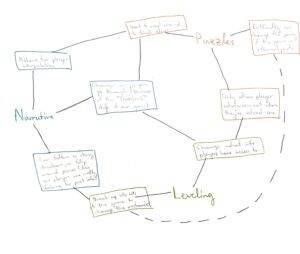
Concept map showing interactions between our core architectures.
Testing and Iteration History
Narrative Testing
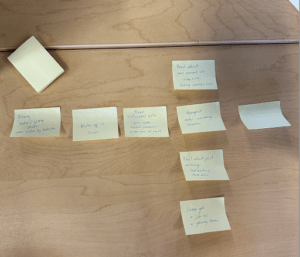
Some of the steps in our narrative, arranged so our playtesters can see the story progression.
May 7th, 2024 – 3 Players
In our first proof of concept playtest, we wanted to see if our narrative felt complete, satisfying, and realistic. Players would traverse the narrative by following the sticky notes along branching paths, representing different arcs of the narrative. At this point in development, we had largely only considered Rowan’s backstory which we wanted the player to uncover by playing the game. In particular, we had considered family history and her relationship with her husband, Sam. Because of this, our sticky notes took the player through the backstory, not the narrative that would unfold in real time as the player played the game.
Key Insights
The primary observation we had when carrying out this playtest was that players were confused in regards to where in the timeline they were playing. Players thought that, as they traversed the backstory, that their “player character” was actually experiencing those events. The length of time involved and the many time skips caused players some confusion. The secondary observation was that players had many questions about details of each event. In particular, they asked about exact dates and how much time passed between each event. We received feedback that more details would be needed to make the world feel fleshed out, and a more specific timeline was needed for realism.
Changes
Because our game actually takes place in the present day, we realized it would be necessary to have a stronger narrative that occurs as the player progresses through the game to help anchor the player and provide guidance as to which parts of the backstory were most necessary. To do this, we added a letter from Rowan’s sister, Ava, which places the player in the present day and explains their predicament. Additionally, we wanted to add an element to the game that would allow you to communicate in real time with some of the characters. This feature would continue to evolve through development. We believed these two elements would give the player a more concrete reason to explore the backstory and a stronger sense of progression as events occurred in the present day in response to the player’s actions.
Secondly, we chose to limit the amount of narrative explicitly communicated to the player. Issues that did not need to be addressed directly, such as that Rowan met Sam at college, were removed from the game. This allowed us to ensure the events we wanted to explicitly mention were much more detail rich and in particular had consistent dates. Alongside this, a photobook in chronological order with labeled dates lowered the amount of information a player might have to keep in their working memory.
Puzzles: Cohesion and Difficulty, part 1
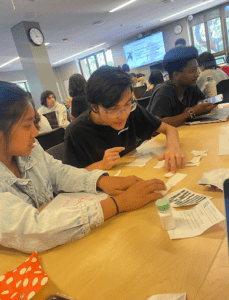
Two playtesters attempting the first version of our puzzles.
May 14th, 2024 – 2 Players
After in class discussion with our lovely CA Nancy, we chose to take a pause on developing our narrative and consider our puzzles in isolation. For this playtest, we brought 5 independent puzzles, most of which made it into our final iteration in some form. These are the hidden map origami puzzle, the secret code photobook puzzle, the anxiety prescription, the blacked out letter puzzle, and the ripped letter puzzle. Our primary goal was to ensure our puzzles felt like the right difficulty. This means that each puzzle offered some challenge, but not too much that players lost motivation and stopped having fun. Additionally, we gave players all of our puzzles at once to test cohesion. Our goal was to have one primary puzzle (the photobook puzzle) with higher difficulty and various supporting puzzles that are easier to complete, preventing the issue of dry spells with no progress by always having a supporting puzzle to work on.
Key Insights
Our primary observation was that the torn letter puzzle was much more difficult than anticipated. It took our players over 15 minutes to complete the puzzle, and they expressed significant frustration at the process. After the playtest, players provided feedback that the difficulty level did not feel congruent with the payoff of information. They also failed to solve the part of the puzzle involving a blacked out letter.
We also observed that players had some difficulty distinguishing between what was and was not a puzzle. This primarily manifested in the anxiety medication prescription puzzle. Players did not know if the anxiety medication prescription was an independent puzzle and were not sure when they had solved it.
Finally, we noted feedback that while these players pressed on despite opening the wrong origami cranes at first, future players may not be so resilient.
Changes
As this playtest was quickly followed by the next playtest, we wanted to make some quick changes to see if we can improve the difficulties we faced. We also chose to keep some elements the same to see if there would be any difference between players. As such, we chose to remove the pill bottle puzzle temporarily, as it seemed to be the biggest point of confusion. We kept the ripped letter puzzle the same to see if players would find it easier when there were less distractions, or if the high level of difficulty faced in this playtest was a fluke. But, we removed the blackout letter puzzle as we only needed one form of letter puzzle to convey our narrative and the ripped letter puzzle was received significantly better. We also chose to keep the origami puzzle the same to see if the next set of playtesters might fail the puzzle.
Puzzles: Cohesion and Difficulty, part 2
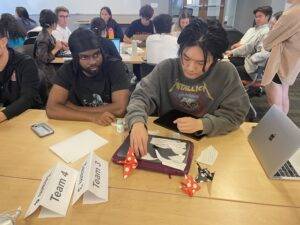
Another pair of playtesters doing the first version of our puzzles.
May 14th, 2024 – 2 Players
This playtest took place immediately after part 1. We found two new playtesters, and implemented the changes discussed previously. Our goal stayed the same – testing difficulty and cohesion.
Key Insights
The most important takeaway here was that these playtesters reacted identically to our first set of playtesters to the ripped letter puzzle. It also took these players around 15 minutes – much longer than our ideal time – and the players also gave feedback that the puzzle was so long that it did not feel satisfying at the end. Much of this difficulty came from the fact that players in both playtests had difficulty realizing that there were two different letters, and kept trying to put all the pieces together onto one sheet of paper. After the playtest, players told us that the fact that there were only four corners made them think that there was only one page. In reality, this was because our letters were written on torn scraps.
However, the removal of the pill bottle puzzle made the experience much smoother, and players had a solid understanding of when each puzzle was over.
Finally, we had the same experience with the origami puzzle where the players almost didn’t unfold the cranes.
Changes
To make the ripped letter puzzle easier, we wanted a clear indication that there were two different letters. Our solution to this was to use two different colored pieces of paper. Additionally, we ensured that each letter was printed on a full sheet of paper so that players can use the corners and edges as guides.
For the origami puzzle, we chose to write notes in all three of the cranes so that players were encouraged to open all three even if they started with opening the wrong crane.
Interactive App Functionality
May 16th, 2024 – 1 Player
For a moment, we took a break from our main game to work on our app, which would be used for the interactive functions we wanted to implement. On the app, players would be able to dial a phone number and, if that phone number is correct, hear a recorded message from an in-game character reacting to the fact that they’ve been called. This playtest was focused on ensuring that the UI/UX felt natural and intuitive.
Key Insights
Our playtester was able to navigate and complete the dialing process with no errors. After the playtest, when asked about which parts of the experience felt unnatural, our playtester pointed out that there was no system message which played while calling someone. Instead, players could simply dial a new number while the phone call message was playing.
Changes
We added a “calling…” message during the phone call, making it impossible for players to dial a new number until the call was over.
Adding a Narrative
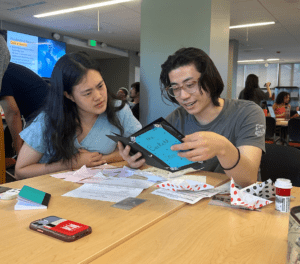
The playtesters read through the Beckett Family Scrapbook as they try to open the locked box.
May 23rd, 2024 – 2 Players
Having iterated on our puzzle design, the next step was to add in our narrative. For this playtest, our goal was to see how much of our narrative players understood after playing through the full game. To integrate our narrative, we replaced all placeholder text and added flavor items, such as Rowan’s ID and journal.
Key Insights
This playtest raised two weak points in how we were conveying our narrative. First, players had difficulty distinguishing who owned which items. As much of the text in our game is written in first person, this led to difficulty distinguishing which character was the player character. Second, players repeatedly overlooked items that were not necessary to solve the puzzles and progress the game. In particular, players showed little interest in reading Rowan’s journal.
Finally, we separately noticed that the game was shorter than anticipated, taking players closer to 20 minutes than 60.
Changes
First, we addressed the issue of item ownership by introducing clearer labels. Namely, we added Rowan’s hospital bag, which would be labeled with her name and contain all of her items. Clearer barriers were needed to limit information overwhelm and help players group related items.
Secondly, we removed Rowan’s journal and replaced it with a negative pregnancy test, conveying the concept of Rowan’s infertility in many less words.
Finally, we lengthened the game by adding two puzzles – a song based puzzle and a password to prevent players from accessing the phone used to end the game. While this lengthened the game, these puzzles also tie in more narrative elements, making it necessary to interact with almost everything to complete the game. In particular, the phone password can be found in the torn letters, meaning that players cannot end the game before completing that puzzle and learning about Ava’s true feelings. Moreover, the song based puzzle requires the player to consider Sam and Rowan’s relationship more thoroughly, where previously players had been more focused on Ava.
These changes, in addition to other smaller changes to improve the fidelity of our game, brought us close to the final form of our game.
Refining the Ending
May 29th, 2024 – 4 Players
After organizing a clearer narrative overall, we wanted to focus on how invested players were in the story and how willing they were to interact with non-puzzle elements. In particular, we wanted to have our players play through the entire game and gauge their reaction to our ending, finding ways to improve upon the existing phone call with Sam.
Key Insights
The players went through the game relatively smoothly, only needing a single hint for the spotify puzzle. They were mostly invested in dissecting the narrative.
One key takeaway falls on making the ending more satisfying to the player. At that point, the ending didn’t portray any grave consequences of the player choice and thus was unremarkable and unsatisfying. Because it could be achieved with little to no narrative understanding, players spent more of their time focused on the puzzles, ignoring some narrative only objects.
Another insight was the lack of incriminating information on Sam and his relationship to Rowan. Because there was so much interaction with Ava in the beginning, she became the first and strongest suspect, so much so that players didn’t have enough reason to suspect Sam seriously.
Changes
We added a choice for the player by creating two endings. By giving players an impactful choice which depended on their understanding of the narrative, they would become more immersed into the experience. Additionally, we made the ending call feel more personal and final by giving Rowan a voice, creating an experience akin to an audio cutscene.
To address the lack of evidence against Sam, we included stolen entries from Sam’s journal that detailed his frustration and motives for wanting Rowan to forget everything, and a postcard of the cliff which is circled. We also moved the Xanax pills into Rowan’s purse and assigned Sam as the one who picked it up for her. We also added Rowan’s journal back into the box as evidence against Sam, and their infertility struggles.
Emphasizing the Narrative
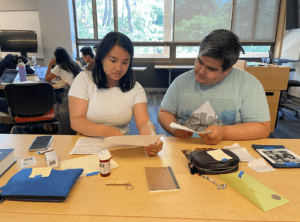
The playtesters consider documents from the game, hoping to find the info they need.
May 30th, 2024 – 2 Players
For this playtest, we wanted to test how players received the ending and the added Spotify and phone passcode puzzles. In addition, we wanted to test whether there was the right balance between puzzles and narrative, or if one aspect of the game dominated.
Key Insights
The players raced through the game, focusing on completing the puzzles rather than understanding the story and following the narrative. Given the description of the game as an escape room in a box and the time constraints of the class, the players focused on the locked items and finding clues that could potentially unlock them. As a result, many of the written context such as the notes or the journal was quickly discarded. At the end, when faced with a choice of who to call, the players essentially chose randomly, without returning to the narrative to figure out which one would have done it.
Players did have some difficulty with the Spotify and scrapbook puzzle. The players did not make the connection between the timestamp of the song matching a date in the scrapbook. In addition, they did not realize that pictures in the scrapbook were removable until given a hint. The players did complete the game fairly quickly, taking less than 30 minutes. However, when asked about what caused Rowan’s amnesia, they were very confused and could not form the connection between Cliff Elizabeth and Ava.
Changes
This was a difficult playtest for us because the players seemed to disregard discovery. While we debated over whether to integrate the feedback they gave us, which primarily included having less text and more puzzle elements, we ultimately remembered that there are many different types of players, and these players may simply not fit into our target audience.
Instead, we reframed the game from a puzzle-based escape room in a box to one that was more story-focused. As described on our website, On Edge is a narrative puzzle box. We hope to encourage players to play the game more slowly and focus on understanding who Rowan was and what happened to her rather than trying to finish the game as quickly as possible, as well as to attract the correct audience to our game.
The next two changes were for the locked bag puzzle, specifically focusing on the Spotify and scrapbook portions. On the back of the letter from Sam to Rowan we wrote “Do you think we made it into the scrapbook?”. This was to help players draw parallels from the timestamp of the song to the scrapbook. In addition, given that players had difficulty realizing they could remove the photos from the scrapbook, we added a post-it note from Ava to the back of the scrapbook saying to “be careful with the photos” to urge players to interact with them.
Functionality and Flow
June 1st, 2024 – 2 players
With what we hoped to be our final changes in place, we wanted to make sure everything ran smoothly and the players could get through the game with minimal overall difficulties. Our goal was to see if players are able to play the game independent of the designers, and use the objects in the game as intended without outside instruction or guidance.
Key Insights
The players were able to play the game almost entirely through without needing outside guidance on how the game actually worked. They did at one point need a hint to keep moving, but we have a list of standardized hints to give. There is now a website that allows players to look up their own hints, but at the time it was not up, so a developer had to write it for them. Other than that, the player experience was pretty seamless and went as intended.
Changes
Very few changes were made after this playtest. This was intended to be a fully functional gameplay experience and it functioned quite well in that regard. The website was completed after this playtest and could be considered a change to the game, but the hints it delivers are the same as the ones given in this playthrough. A couple of cosmetic changes to rules and the box were made to make them fit into the game more cohesively, but this was otherwise a complete version of the game.
Final Playtest
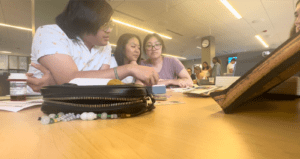
Our final three playtesters discuss their finds.
June 4, 2024 – 3 Players
This was our final playtest, and the game was in its final state at this time. We wanted to see the completed game in action, observing whether the players understood the narrative, their final decision in who to call to end the game, and their overall thoughts and enjoyment of the game.
Key Insights
The players seemed to really enjoy the game, working together to piece together the narrative and solve the puzzles. They interacted with every single object in the box and read all the letters, something that previous playtesters did not do. The players did have some difficulty with the first locked bag puzzle, but after receiving two hints, they were able to complete the rest of the game without any additional hints. After some debate, the players chose the “good ending” by calling Sam. This was great, as our intention was for players to struggle and debate over who to choose, as we wanted a climactic ending.
Changes
Given the game was in its final, desired state at this time, we felt that no additional changes needed to be made to the physical items. However, we did choose to further refine the hints, adding pictures as well as expanding the number of hints to provide more specific guidance to players. Overall, the playtest went very well and the game is in a playable, well-received state!
Full video can be seen here
Architecture
Narrative Architecture
We were careful to ensure that the story integrated well into our game’s mechanics. In particular, you can find evidence of this integration in our May 23rd playtest, where we first introduced our narrative. In this playtest, we noticed that by placing our narrative in parallel with the puzzle, such as providing supplementary material upon unlocking a new set of items, players could skip over narrative elements even without meaning to. To solve this issue, we strove to integrate our narrative into objects that players had to interact with to solve puzzles. The reason we knew this would work was because we were methodical about our post playtest qualitative interview questions. After playtests, we asked targeted questions on what parts of the narrative players remembered, and observed that they could specifically remember things like Rowan graduating high school or Ava getting a job because they read it in the scrapbook despite these details not being directly related to solving the scrapbook’s puzzle. This information told us that players would remember narrative elements if they were conveyed on a puzzle related object more so than if it were in a standalone object. Thus, by the end of development, all core narrative elements were integrated into some necessary object such as the letters or the phone call.
But, the question continued to hang over our heads as to how to make players invested in the narrative, truly stepping into Rowan’s shoes. To solve this, we made the ending interactive, giving the players a choice between choosing to call the sister or the husband for help. By making whether or not players win the game dependent on truly understanding the narrative and the intentions of the characters within it, we noticed that playtesters became significantly more likely to interact with “optional” elements such as Rowan’s therapy journal.
Of course, by designing a game that required the player to think so deeply about our narrative, we had to ensure that there was depth to uncover. One of the primary pieces of environmental storytelling we focused on was backstory. Early on, we crafted a timeline of Rowan’s life, from her birth to the present day. An observant player would be able to piece together this entire timeline from playing our game, including when Rowan went to college, was married, how long she was in the hospital, and the date on which the game takes place. The second primary consideration was location. Because we wanted a cliff to be involved in one of the primary plot points, we set the hometown to be a small town in West Virginia, a place with many cliffs as well as high poverty rates, explaining why Ava might need to get a job to support the family. Rowan, meanwhile, went to Stanford for college and never came back, a realistic story in much of small town America currently experiencing brain drain. It was important to us to consider all of these elements so as not to take players out of the magic circle with inconsistencies or confusion.
Importantly, we kept a strong sense of ludo-narrative cohesion when integrating our puzzles despite the difficulty of keeping puzzles realistic. As you will notice, each puzzle has a good reason for being present, and no character ever has info dumps, especially not about things they shouldn’t know. Puzzle objects are items that might realistically be in Rowan or Ava’s possession, and a sense of immersion is created through heightened tactile realism, such as Ava’s notes being on notepad paper and Rowan’s pill bottle being a real prescription bottle.
When we designed our main characters, Rowan and Ava, we wanted to give both characters depth and development. For Rowan, this was considerably easier, as the player’s decisions serve as emergent character development for Rowan. As players explore each section of the box, they start to form opinions about the characters they meet. These opinions converge in deciding who to call at the end of the game, where Rowan goes from a blank slate to someone full of opinions and personality created by the player.
Ava, however, needed to have a more prescribed narrative arc. We went through many considerations for how Ava got to the point of attacking Rowan, but decided on a slow and steady downward spiral after the death of her mother which escalated after Rowan left for college and never came back. We had to be careful to make her descent feel natural and believable, as in previous iterations of the game she had felt almost comically villainous. This meant leaving hints throughout not just Ava’s own writings, but Rowan’s as well. In this way, Ava goes from the helpful mentor figure at the beginning, offering our player their first note and pieces of advice, to the villain at the end.
An important point to our narrative architecture is that you cannot understand everything at once. By slowly unlocking the narrative alongside Rowan, we create a sense of emotional investment by the end of the game. The player has to think hard at times to understand the full picture, but that effort is rewarded when players save the character they’ve been with since the beginning.
Level Design
In our MVP, we can see two types of progression: a narrative progression where the player slowly unravels information and changes their viewpoint, and a progression after completing each puzzle. For this section, we will be mainly focusing on the latter. The narrative progression is explained in the previous section.
In the whole scope of the game, we organized around three levels:
In the first level, players discover the world, the immediate relationship between each character, and the boundaries of information. In particular, the very clearly visible locked box and bag with enticing “Don’t touch” notes motivate the player to seek for a way to open them. Through their search, players will find that since there is no key to unlock the box yet, and so the next thing to find is some code for the alphabetic lock to the bag. To find this code, players complete the spotify puzzle. In many of our playtests, we’ve noticed that the spotify puzzle was the most challenging; however, it was a very effective puzzle that required them to go back and forth into every item, front and back. This meant that if the player wanted to progress any further, they needed to look thoroughly at all the information and progress narratively too.
Once the bag is unlocked, the players have entered level two. At this point, the only thing left to look for is the key. This level is incredibly simple, meant as a break after one of the most challenging puzzles in the game where the player can almost “walk through”. Under the cushion of the jewelry box, the key can be easily found and players can finally unlock the box. This level reveals to the player who the box belongs to and its value to its owner. The player’s in-game phone is also revealed which signals to the player of the true end goal of the game. Not only does it reveal a sinister undertone of the game but it urges the player to call someone at the end.
The third level begins when the players unlock the box and they see all the information that has been hidden from them. The puzzles here are ripped letters and folded cranes which perfectly immerse the player in the hateful relationship between Rowan and Ava and Ava’s lost hopes. The last puzzle of this section requires the player to finally piece together what happened to them and decide who to blame. The relative ease of the letters and cranes give room for the player to solve the hardest puzzle which is the narrative puzzle.
In summary, the narrative progression of the game is important and thus, the progression of the puzzles need to emphasize that.
Spatial Architecture
Although our player never moves during the game, there is still significant spatial architecture design present.
First, we considered the space the characters move around in, both in the backstory and during the events of the game. As explained previously, a lot of consideration went into the real world setting of the game, which fits into both the narrative and spatial architecture buckets. This consideration means that usage of space is fully immersive.
We also considered important fictional landmarks that would show up throughout the backstory. In particular, there is Cliff Elizabeth, the woods, and the Beckett house. By noticing that Ava mentions finding Rowan in the woods in the introductory note, players can deduce using a map found later in the game that Rowan was in the woods surrounding Cliff Elizabeth. This information is kept purposely obscure until the player finds the map inside the paper cranes near the end of the game, after which understanding the layout becomes very easy.
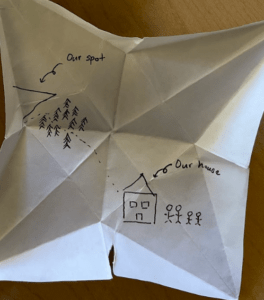
The map which players discover by unfolding the paper cranes.
But, the most important spatial architecture comes from the design of the space within the game box. Originally, we had little separation between the items inside the box. However, we noticed in playtesting that lack of organization caused confusion. So, we added artificial dividers such as Rowan’s hospital ziplock bag, Rowan’s purse, and Ava’s envelope. These dividers can be opened at any time, but their existence helps players keep track of which items are related both in time and space. Additionally, many of these dividers were labeled for further clarity, such as Rowan’s hospital ziplock bag being labeled with her name to make it clear that these are the belongings Rowan had on her when she was admitted to the hospital.
Though those previously mentioned are artificial dividers, dividers were also sometimes used in a functional way. Namely, these are the two locked compartments which originally cannot be accessed. The usage of physical compartments within compartments allow us to purposefully design the delivery of information at appropriate times. This can be thought of as analogous to unlocking a new part of the map in a video game when you level up.
Finally, our game goes above and beyond to create a deeply immersive and interactive experience. Players are encouraged to do anything they’d like to any object. At times, they are even required to destroy certain elements, such as the origami crane and pictures in the scrapbook. One of the main joys of our game comes from being able to pick up and examine every item, something a virtual experience is unable to accomplish even in sandbox experiences.
In summary, our game applies spacial architecture design concepts by thinking of our game box as our space and each object as a location.
Accessibility
We wanted to integrate accessibility into our design from the very beginning. In particular, we recognized that we were creating a game covering topics which may be difficult to many.
Firstly, we integrated a content warning into our instructions sheet in a prominent location. As is the nature of a detective-type game, players might come to certain conclusions that are not actually correct. Because of this, the content warning doesn’t just include topics directly in the game, but also concepts that players could believe or assume, such as domestic violence.
Additionally, we recognized that we were creating a very tactical game that might be enjoyed by people who are blind or have low vision. However, our game involves many text documents. To solve this barrier and make our game accessible to a larger audience, we created an accessibility document which includes a plain text rendition of each of our text based audience. The document can be read aloud by a screen reader or magnified to a larger size. This document also includes transcripts of our audio elements, so that those who are hard of hearing can still enjoy the full experience.
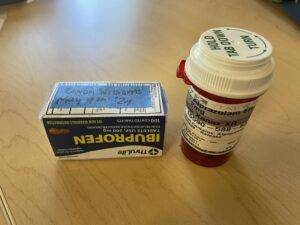
Mock medications, one of the types of objects that add a 3D aspect to the game.
This document is a prime example of how accessibility measures can help everyone, as we quickly realized that this document could be useful for many other purposes such as translation or just someone who spilled water on one of the papers.
Additionally, we made a hints website to help guide players who are struggling. This website can also be used with screen readers, magnification, translation, and other such assistive technology accessible on personal devices.
Link to Accessibility Document: https://docs.google.com/document/d/1z85INWp1iXRpPkryvN5YadLECwYapbxPWsfFFg7gmwI/edit?usp=sharing
Taking Risks/Conclusion
Though there were some veteran game designers in our team, creating such a rich tactile and narrative focused experience such as On Edge was new for all of us.
One of the main risks we took was to create a multimodal experience. Throughout the game, the player interacts with audio, web, phone apps, paper, and more. As a student team without access to professional manufacturing, we had to get very crafty and thrifty. Our team had to learn laser engraving, origami, godot, and many more skills to put together the final product, but we felt that chasing this goal was worth it for the truly immersive experience we were able to create. After all, no one simply leaves a pile of paper in their room. Real stories are told through all mediums. We felt that this made our product stand above many other detective or escape room type games.
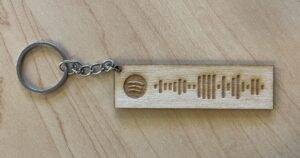
A custom laser engraved keychain, part of the Spotify puzzle.
Another difficulty we faced was in conveying our two-tiered narrative. Integrating a backstory into our game mechanics was difficult as it is, but we also had to create a narrative taking place as the players navigate the game, culminating in a satisfying ending. This is part of the reason a multimodal experience was so important to us, as we wanted a way for it to feel like the characters in the game existed at the same time as you and could be interacted with. It also provided a way to let player choices matter. In many similar games on the market, you simply play until you feel like you have solved the mystery, then see if you were right. That experience is much more like reading a book than playing a game. We wanted to create something that felt interactive and impactful.
Overall, we learned so much from this experience, and through its highs and lows, we are proud of the game we created. We hope you love it just as much.
– Team 3 (Amy Chang, Blain Engega, David Fang, Sherry Yan, Zinnia Cooperrider)
The Game
Images – https://drive.google.com/drive/folders/1-WQqgCK-qAGTOmMB8RKC2AMdsdSeXNRG?usp=sharing
Print n Play – https://drive.google.com/drive/folders/1kH0wqXHj6emb8mhkvaHFtjIaumVLylkv?usp=drive_link
App – https://amchang.itch.io/on-edge-companion-app
Please note: there is a glitch with itch.io version where you will have to refresh the page to return to the phone call screen if you navigate to the messages screen.
Accessibility + Hints website: https://blain342.wixsite.com/on-edge


